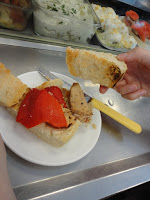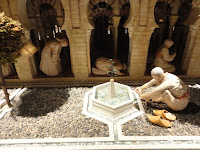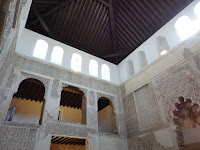 |
| Pics! |
Everything so far brought us all the way to 8:30, so we had a bit of a wait before the train left. We of course settled into the hard blue chairs routinely found in bus stations all over the world and pulled out our computers. At around 9 we’d had enough of that, and walked off in search of our train. There were 4 different ramps leading down to the trains, and we didn’t know which to take. So we went to the first ramp - labeled “1 and 2” - and showed our tickets to the security guard at the x-ray machine. She shook her head and waved us on. We walked a bit farther - to “3 and 4” - and tried again. The lady there took pity on us, and said in perfect English with a French accent: “You always need to verify on the board which platform you need. You see, it says Cadiz is on platform number 6. The train will go to Cadiz after it stops in Seville.”
 |
| Still Cordoba - across from the hostel |
 |
| Seville |
Between us and our backpacks and an entire tour group loaded down with rolling suitcases and various other bags, we stuffed the bus full when it arrived. We didn’t get a seat, and struggled to find a bar to hold and keep ourselves upright as the bus turned corners and stopped more quickly than it should have. The ride was ridiculously short, especially considering they’d charged us each $2 - we could have walked it in no time! We still had quite a hike anyway, so a bit extra wouldn’t have made much difference.
We had an hour before we could check in to the hostel at 12:30, so we dropped our bags off so we could walk around the town without being bogged down. The clerk wrote our names down on cards and tied them to the bags with a rubber band. We traipsed off into the very very hot May Sevillian sun to find something to eat for lunch.
We found a strange little bar called Bar Duque that was sort of in a trailer, and we did the thing where you walk in a bit zig-zaggedly to show that you haven’t really committed to eating there. But, the place had tapas and an English menu, and it looked rather good, so we settled in at the bar (which was pretty much all there was in the tiny space) and ordered a hamburger and a “tuna on toast”. We first had a long conversation with the bartender about what was on the hamburger, as our choices were “hamburger,” “hamburger with ham”, and “hamburger with vegetables”. The bartended eventually decided that the regular hamburger would come with lettuce and tomato, and so that’s what we ordered. When it came out it was clearly a store-bought frozen patty that was quite possibly pork instead of beef, but it was still pretty good. The tuna came with roasted red peppers and tomatoes on a toasted sandwich (it was a piece of tuna steak, not to be confused with tuna from a can), and it was delicious. We also asked for tap water (“aqua de grifo”, as we learned from Jose in Madrid), and were delighted to get ice cold water from the beer tap instead of lukewarm water from the faucet. The place was a hit for us.
The chef wandered out as we were finishing up, and we waived him over and displayed our money in an international “we are ready to go how much do we owe you” gesture. I could follow enough of the Spanish to understand the dialogue that followed: he called to the waiter across the bar to find out what we’d had; the waiter answered that he should know we’d just had a hamburger and a tuna sandwich. But the chef didn’t know who had what. The waiter explained that we’d taken a knife and cut everything in half (which the chef had missed, being in the back), so he thought we just needed the total and we’d figured out how to pay on our own. The chef turned his attention back to us and clasped his hands together. “Total?” We repeated the gesture and nodded. “Total!” We actually each had our 2.25 Euros ready, since tax is already included in Spain and we could do the math ourselves. We just needed to make sure they hadn’t added anything for the water or the little breadstick basket or eating at the counter or anything else.
After lunch we returned to our hostel - the Oasis. It was brand new and very cheap - only about $16 per bed. We were staying in a 14-bed room, and the hostel had gotten some mixed reviews since it had only been open a month and only had 2 bathrooms for all 14 people. However, as soon as we saw our room we were very happy! Even though there were 7 bunks, the room was really 2 rooms, so ours only had 4 bunks, or 8 people. The second room held the other 3 bunks, and also had a cute little balcony (we were on the 2nd floor). We also had a tiny patio just for our room, with little wicker chairs and potted plants. And under each bed was a giant drawer that locked that was about twice as big as each of our backpacks, so we could put our packs in the back and still have room for clothes, toiletries, food, purses, computers, and all the other daily items we needed in the front.
Since it was the middle of the day, we took advantage of the empty bathrooms and did some laundry. It was my first time doing laundry, and I filled the sink with water and scrubbed my clothes on the pink “Zote” laundry bar I bought for this trip. Mostly I just scrubbed the “problem areas”, and then wadded the piece of clothing up to get it all nice and soapy. Tricia and I strung a clothesline around our bunk and hung our laundry on three sides, making a curtain of clothes for me on the bottom bunk.
We decided to spend some time exploring Seville, so we walked to the other side of the city to hit a couple of little churches. In front of one was a shady square full of couples and kids relaxing and playing on bikes and scooters. It was a really nice little scene, and we sat and people watched for a while. As we began our walk back in the direction of our hostel we passed a grocery store called LIDL which had really cheap prices - like an Aldi of Spain. We bought some chocolate-covered cream-filled pastries for about a dollar and made a note to return for real food (although we never did make it back there).
There was a museum called the Centro Andaluz de Arte Contemporaneo that was free on Tuesdays, so we walked over the bridge across the river Guadalquivir to check it out. It was situated in a huge monastery on a ton of land, and the entire place felt like a ghost town. We walked around aimlessly, not really sure if the occasional gate in a wall was an invitation to enter or not. Finally, we passed a bike rack with about a half dozen bikes in it, so we figured we were getting close to where we wanted to be.
We walked through a completely empty courtyard where an encouraging little sign said “tickets” with an arrow. On the walls were what we took to be graffiti: someone had drawn pictures of dollar signs in strange positions with the caption “Money Having Sex”. Soon after we learned that this was actually art, The artist is the American Jessica Diamond, and her other work at the museum include giant letters reading “I HATE BUSINESS”, the slogan “Faith in Paper”, and “Is this all there is?” That was it. I wasn’t sure I really got her work.
Finally, we arrived at the ticket office. We asked the lady if it was free, and she shook her head sadly. It used to be free on Tuesdays, but now only on Sundays. Oh well, we’d come all this way, how much is it? Well, it is 1.50 Euros each. As we began looking for change, the lady spoke again: on Tuesdays it is only free from 7 to 9 pm. We looked at the clock: 6:45. Seriously? Um, okay, we’ll go ahead and wait. We sat down in the air conditioning of the reception area, and watched as several other people came in and had the exact same conversation: “It costs1.50.” “I thought it was free today.” “No. It isn’t free today. It’s only free on Sundays. On Tuesday it isn’t free until 7.” Each person looked at the lady like they were sure they were missing something, and then went back outside to wait until 7.
At 7 the lady smiled sweetly and called us over and handed us our free tickets. We learned that most of the exhibits are temporary international exhibits that stay for three months and then move on to a different museum. This was particularly confusing to us in the exhibits where they’d painted directly onto the walls of the monastery as with Jessica’s work, or in the Marxist exhibit where three rooms of the monastery were painted blood red and then filled with books and couches to facilitate discussion and provoke thought. (I came to the conclusion that while I don’t understand modern art, I really have no use for contemporary art: painting a room red and signing your name to it doesn’t make you an artist in my opinion.) The theme of the entire museum was “The Political Constitution of the Present” (I didn’t make that up - it was in the pamphlet). There were Italians bemoaning the apathy of the populace, a room full of tiny clay people apparently depicting famous scenes which were also played out on little tv screens (the clay people played them out, not real people - the only one I recognized was from 9.11), a timeline of the fall of the USSR stretching through several rooms, another timeline depicting Lebanon’s conflicts (in English, not Spanish), one entire wall devoted to clippings of every time a country was mentioned in one particular newspaper (just the county’s name, over and over; apparently this is repeated every year - we were looking at 2010’s offering) and another entire wall where the artist repetitively writes the word “woman” on note cards, but half with her left hand to symbolize visual tension and changes of rhythm. Overall, it was quite strange.
 The thing about the monastery is that it has a ton of history all by itself. For example, Saint Anne’s chapel held the body of Christopher Columbus for 25 years back in the 1500s. Today it’s full of articles cut from newspapers of genocide and slavery from around the world that the artist didn’t think made big enough headlines. The “Little Cloister” is one of Seville’s finest examples of Mudejar architecture, combining Christian and Moorish styles. Back to art again - a very strange permanent exhibit was created in the monastery’s pools. There was a lot of flooding when the monastery was in use, and as a tribute to the monastery and the river an artist submerged pieces of the architectural remains of the building (mainly columns) into the pools.
The thing about the monastery is that it has a ton of history all by itself. For example, Saint Anne’s chapel held the body of Christopher Columbus for 25 years back in the 1500s. Today it’s full of articles cut from newspapers of genocide and slavery from around the world that the artist didn’t think made big enough headlines. The “Little Cloister” is one of Seville’s finest examples of Mudejar architecture, combining Christian and Moorish styles. Back to art again - a very strange permanent exhibit was created in the monastery’s pools. There was a lot of flooding when the monastery was in use, and as a tribute to the monastery and the river an artist submerged pieces of the architectural remains of the building (mainly columns) into the pools. On our way back to the hostel, we stopped at a Corte Ingles (which spanned a city block and had 4 flags pointing it out on our map). We found the grocery store in the basement of the 7 story building, and picked up cereal on a clearance shelf for $1.50, boxed milk that is shelf-safe until you open it, and a 6-pack of gala apples. Our total came to $6. We returned to the hostel and had some cereal. I was amused by the box, which had every sentence translated into 22 different languages and had serving instructions, for those people who had never eaten cereal before.
Our last stop of the evening was to a bar for some free Flamenco with a small group of other hostel-ers. Even though there were only 6 of us, the bar was completely packed, and we had to climb over one table to get to the only empty spot in the place - a table with 3 chairs. Tricia and I shared one, two girls from Toronto took the other two across from us, and the other 2 girls leaned on the wall behind us. The dancers had a great time, even pulling their friends from the audience to dance for us as well and goading the guitarist into showing off a few moves. What started with 2 female dancers ended with 4, and 5 if you count the guitarist. I’m actually starting to like Flamenco more as we see people who have more fun doing it, although Tricia likes the more technically proficient dancers better. Of course, the better dancers aren’t usually free. J
We considered having a drink since we’d stayed at the bar but hadn’t purchased anything, but since no one had paid any attention to us in the slightest we gave it up and walked home with the girls from Canada, who were also on a 3 month trip, having just finished their semester of school (they were born in ‘88 - ah, we are getting old!). The others went out on a pub crawl, but we’d had our fill of staying up until 4 am in Madrid and had had a full day already. Plus, in a 14-bed dorm the likelihood of our getting 7 hours sleep if we started at 4 am was absolutely zip. So we walked home and found our bunk and called it a night.















































